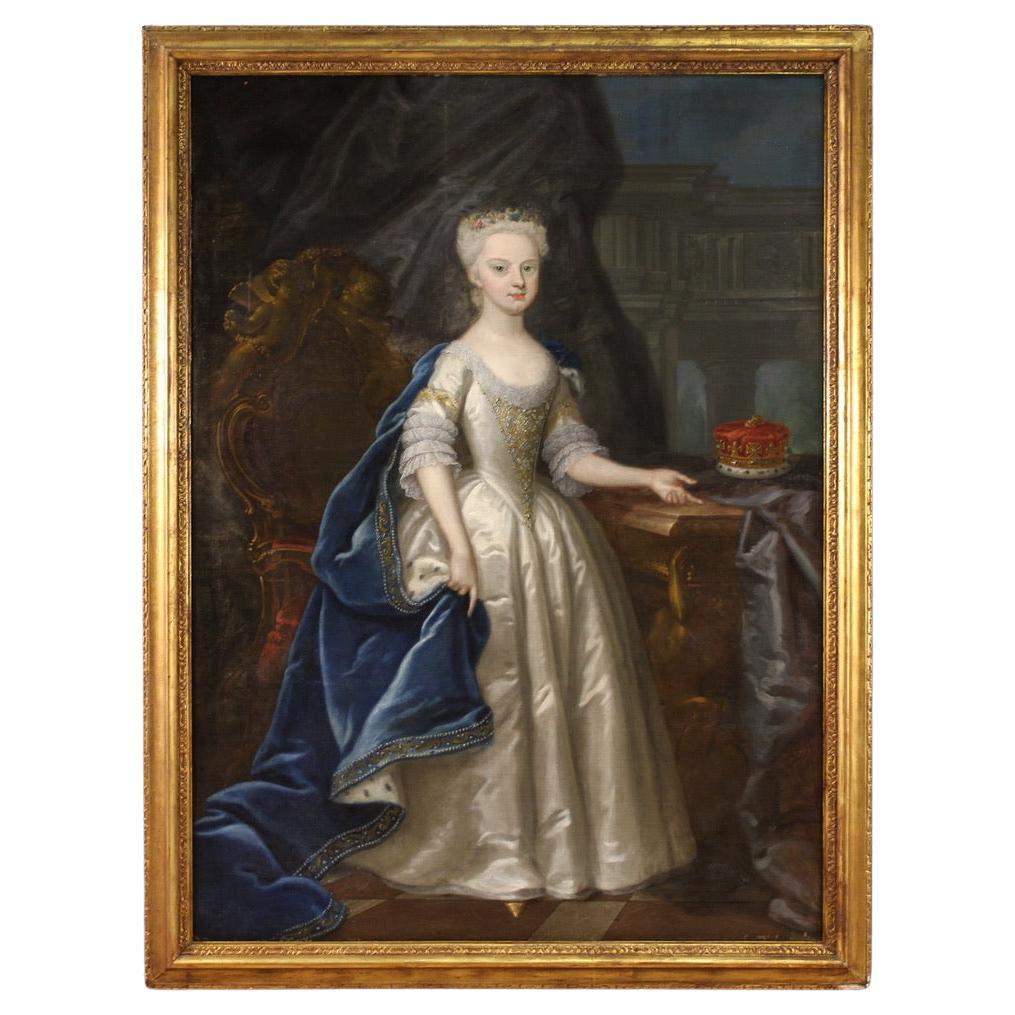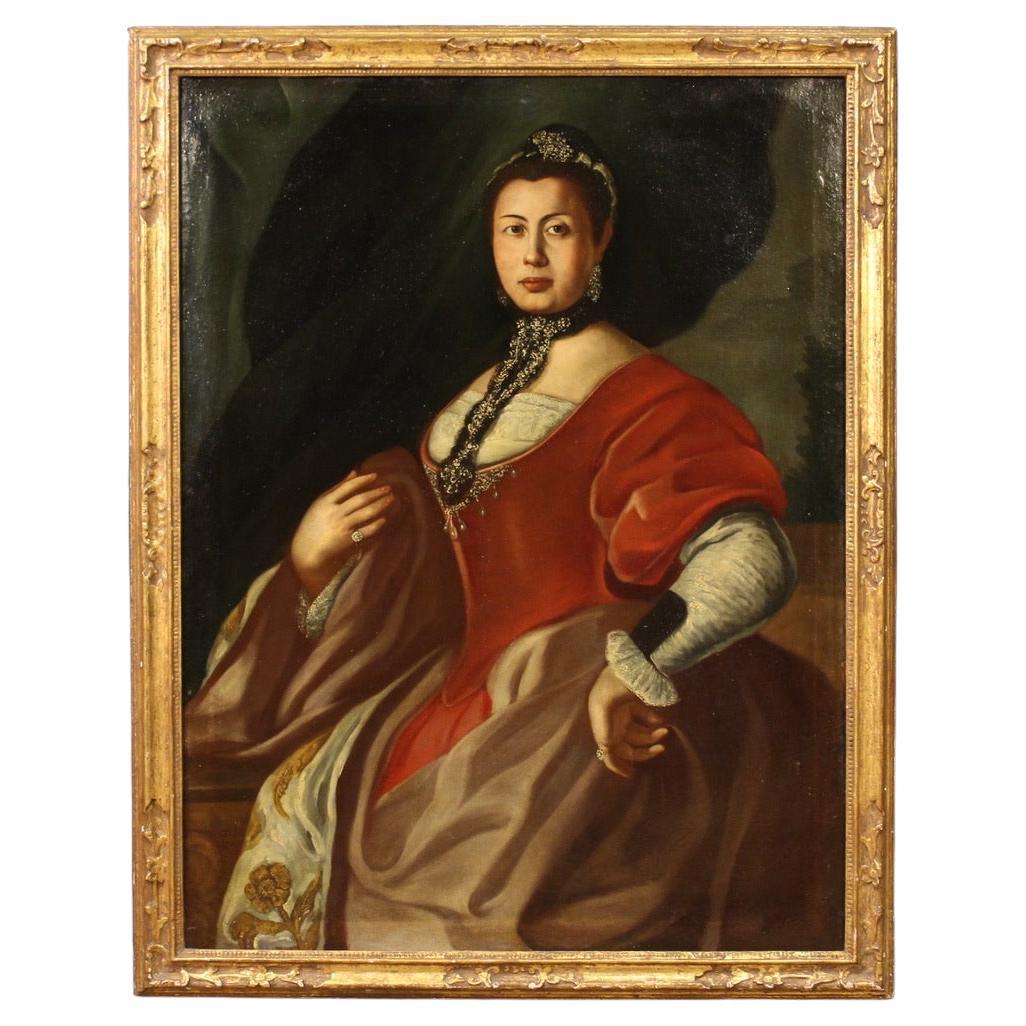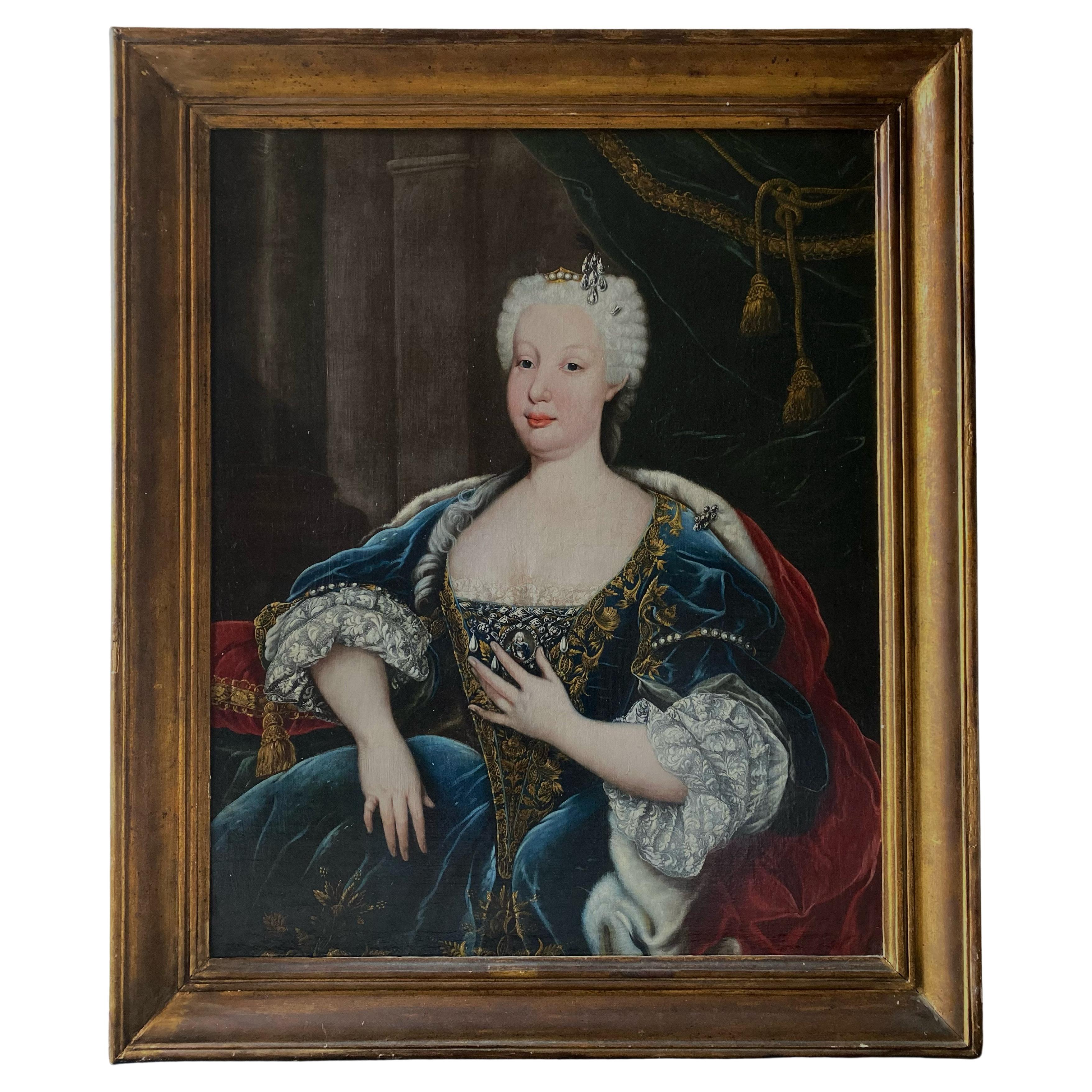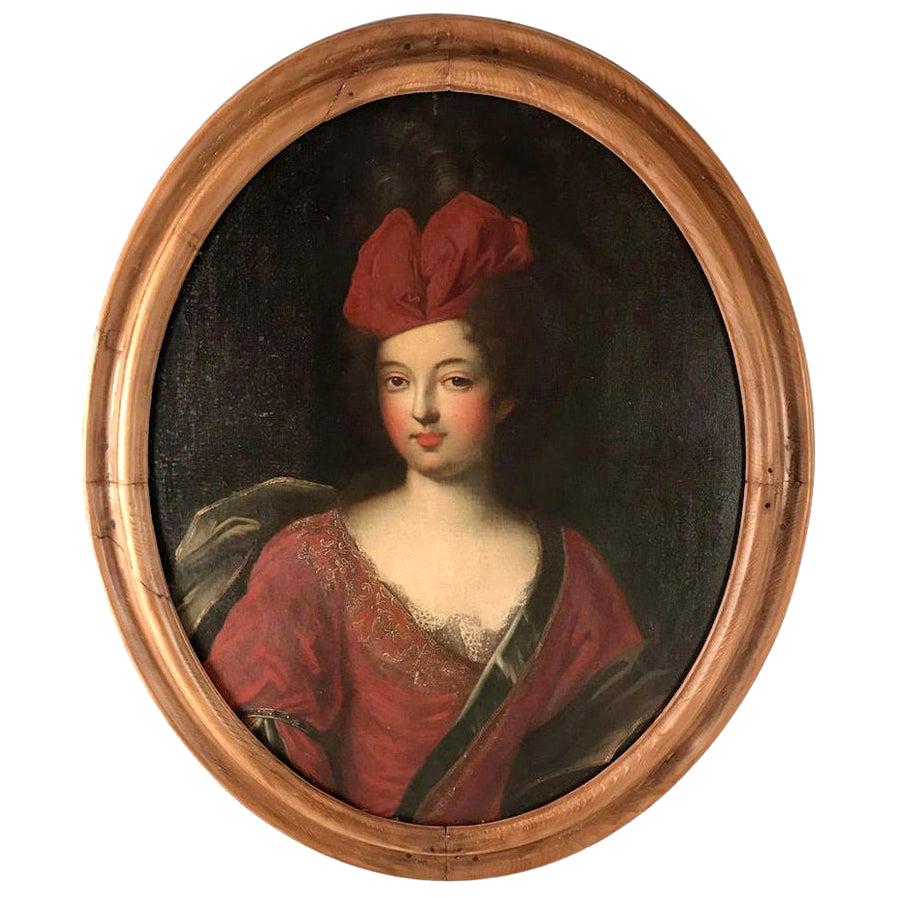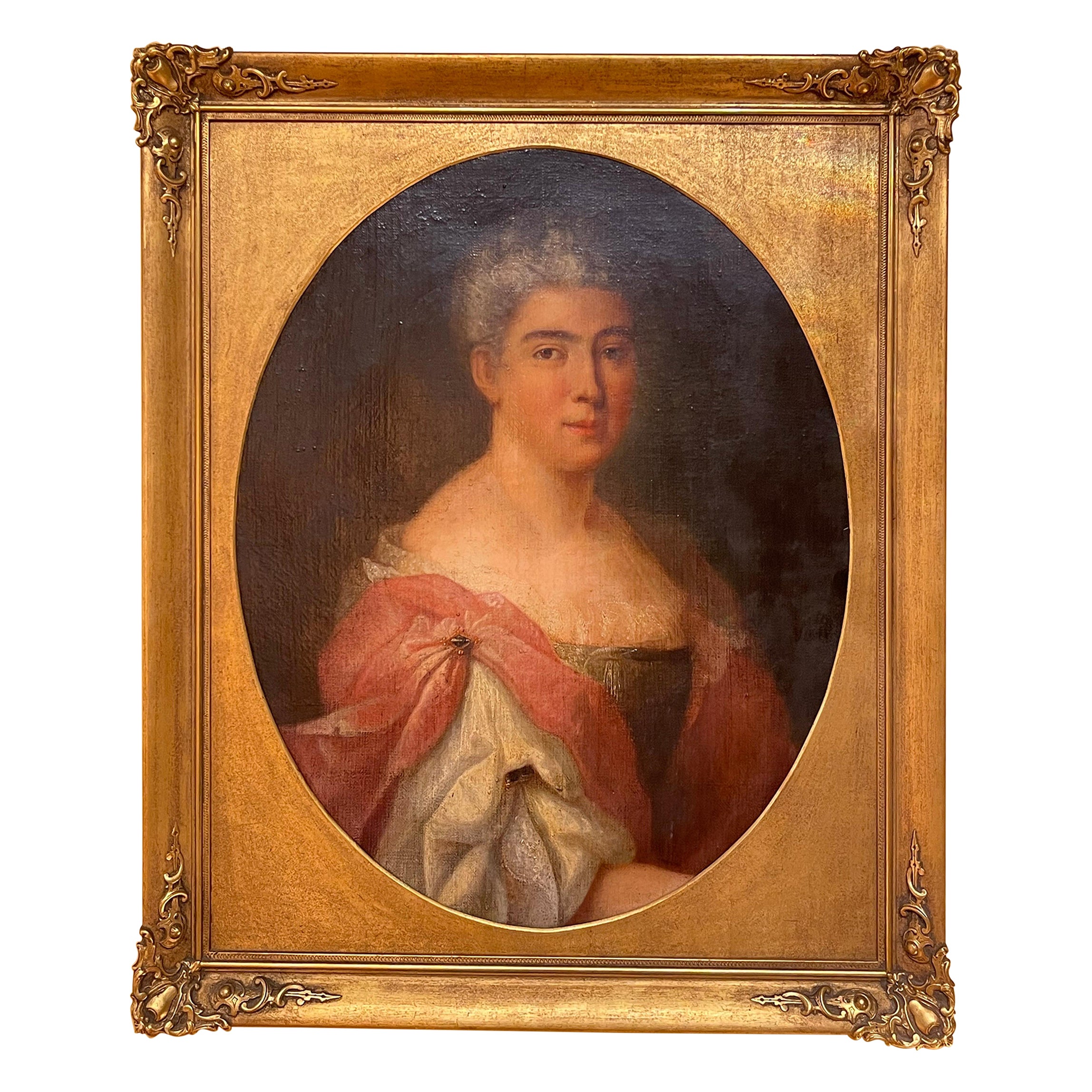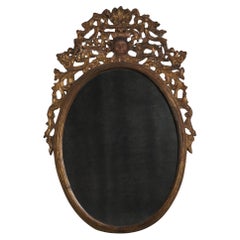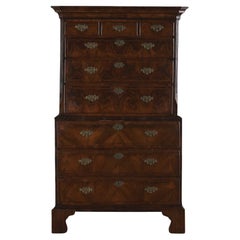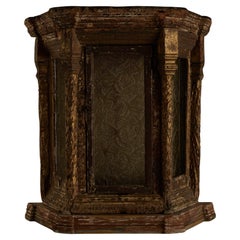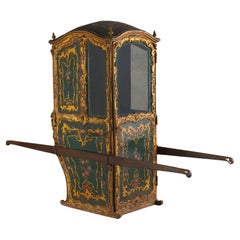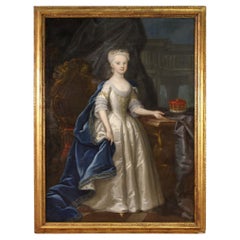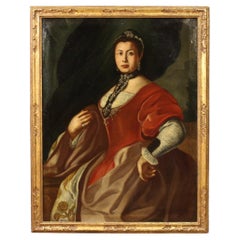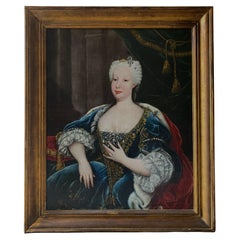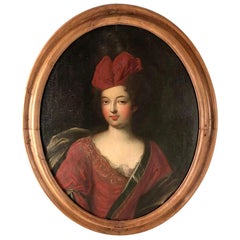Items Similar to Continental School Oil Portrait of Maria Theresa (1717-1780)
Want more images or videos?
Request additional images or videos from the seller
1 of 9
Continental School Oil Portrait of Maria Theresa (1717-1780)
$12,500
£9,556.92
€11,007.64
CA$17,516.33
A$19,555.34
CHF 10,246.70
MX$239,376.53
NOK 130,133.23
SEK 122,699.12
DKK 82,151.12
Shipping
Retrieving quote...The 1stDibs Promise:
Authenticity Guarantee,
Money-Back Guarantee,
24-Hour Cancellation
About the Item
Continental School oil portrait of Maria Teresa: Portrait of Maria Theresa (1717-1780), Archduchess of Austria, Holy Roman Empress, Queen of Hungary and Bohemia
This portrait was owned by Leonard Stanley for decades. It hung behind his desk at his store on Melrose Avenue in Los Angeles. It was painted during the time of Maria Teresa’s life. It’s an amazing portrait and an amazing painting.
- Dimensions:Height: 41.5 in (105.41 cm)Width: 33.25 in (84.46 cm)Depth: 1.5 in (3.81 cm)
- Materials and Techniques:
- Place of Origin:
- Period:
- Date of Manufacture:18th C
- Condition:Wear consistent with age and use.
- Seller Location:Los Angeles, CA
- Reference Number:1stDibs: LU9932242417222
About the Seller
4.0
Vetted Professional Seller
Every seller passes strict standards for authenticity and reliability
Established in 1993
1stDibs seller since 2024
11 sales on 1stDibs
Typical response time: 1 hour
- ShippingRetrieving quote...Shipping from: Los Angeles, CA
- Return Policy
Authenticity Guarantee
In the unlikely event there’s an issue with an item’s authenticity, contact us within 1 year for a full refund. DetailsMoney-Back Guarantee
If your item is not as described, is damaged in transit, or does not arrive, contact us within 7 days for a full refund. Details24-Hour Cancellation
You have a 24-hour grace period in which to reconsider your purchase, with no questions asked.Vetted Professional Sellers
Our world-class sellers must adhere to strict standards for service and quality, maintaining the integrity of our listings.Price-Match Guarantee
If you find that a seller listed the same item for a lower price elsewhere, we’ll match it.Trusted Global Delivery
Our best-in-class carrier network provides specialized shipping options worldwide, including custom delivery.More From This Seller
View AllSicilian Gilt Mirror, 18th C
Located in Los Angeles, CA
Magnificent oval Sicilian gilt wood mirror from the 18th Century. This antique mirror is adorned with intricate carved scrolling acanthus leaves and topped with a rosy cheeked cherub.
Category
Antique Early 18th Century Italian Wall Mirrors
Materials
Gesso, Mirror, Wood, Giltwood
$12,000
George III, Walnut Chest on Chest, England, Late 18th C
Located in Los Angeles, CA
An absolutely beautiful, beautiful piece.
Category
Antique 18th Century English George III Dressers
Materials
Walnut
17th Century Reliquary
Located in Los Angeles, CA
A beautiful charming piece with contemporary repairs on the base as well as the top.
Category
Antique 17th Century Italian Vitrines
Materials
Glass, Giltwood
$5,300
Italian Carved and Gilded Sedan Chair with Original Interior and Glass
Located in Los Angeles, CA
Museum quality. Of all the examples we've seen, this is the best.
Category
Antique Mid-18th Century Italian Neoclassical Armchairs
Materials
Bronze
Miniature Painted French Armoire, 19th C
Located in Los Angeles, CA
Antique, miniature armoire - perfect for holding jewelry!
Category
Antique 19th Century French Wardrobes and Armoires
Materials
Wood, Paint
Rare 17th C Table Folding Center Table With Drawer
Located in Los Angeles, CA
It is a very rare to find a 17th century table in such good shape. This handsome Italian folding center table is supported with eight richly carved legs and is extendable from 34" - ...
Category
Antique 17th Century Italian Drop-leaf and Pembroke Tables
Materials
Iron
You May Also Like
18th Century Oil on Cavas Antique Painting Princess Portrait, 1730
Located in Vicoforte, Piedmont
A splendid portrait painting of a noblewoman from the first half of the 18th century. Painting oil on canvas depicts a young aristocrat standing before a Baroque throne, using a pict...
Category
Antique 1730s Austrian Paintings
Materials
Canvas
18th Century Oil on Canvas Italian Antique Lady Portrait Painting, 1750
Located in Vicoforte, Piedmont
Refined Italian painting from the 18th century. Oil on canvas artwork depicting a splendid female portrait, a noblewoman in an elegant dress embellished with jewels, lace and embroid...
Category
Antique 1750s Italian Paintings
Materials
Canvas
Portrait of D. Maria Bárbara De Bragança, Circle of Louis-Michel Van Loo
By H. van Loon
Located in Lisboa, PT
PORTRAIT OF D. MARIA BÁRBARA DE BRAGANÇA (1711-1758), QUEEN OF SPAIN
Circle of Louis-Michel van Loo (1707-1771)
Oil on canvas
Her Royal Highness, the Infanta Maria Barbara of Braganza (1711-1758) was the first-born child of King John V of Portugal (1689-1750) and his queen consort Maria Anna of Austria (1683-1754). Born in December 1711, she had the Convent Palace of Mafra built in her honour following a vow made by her royal father. Her status as Princess of Brazil, inherent to 18th century Portuguese presumptive heirs, would however be superseded once the queen gave birth to two male princes, D. Pedro (1712-1714) and D. José (1714-1777), preventing her from ascending to the throne.
Daughter of one of the most illustrious monarchs of his time, Maria Barbara was carefully educated to become a fond admirer of the arts, and of music in particular, having had the Italian composer Domenico Scarlatti (1685-1757) as her music teacher.
On the 10th January 1723 the young princess was betrothed to the Infante Ferdinand of Spain (1713-1759), eldest son of King Philip V (1683-1746). Six years later, on the 19th January, she entered her new country in a carefully choreographed ceremony that became known to history as the “Exchange of the Princesses”. This unique event took place on a specially built Bridge-Palace, a wooden, luxuriously decorated structure that included various modules and rooms, on both banks of the river Caia, the natural border between the town of Elvas in Portugal and of Badajoz in Spain. Simultaneously, on the same day that the Portuguese Infanta crossed the border to marry the Spanish Crown Prince, her new sister in law, the Infanta Mariana Victoria of Bourbon (1718-1781), her husband’s sister, crossed the same bridge in the opposite direction to marry Prince D. José, the Portuguese heir to the throne.
Once married, Maria Barbara would spend 17 years as Princess of Asturias, only becoming Queen of Spain at her husband’s accession following the death of Philip V in 1746. She is portrayed in the 1743 painting by Louis-Michel van Loo (1707-1771) now in the Prado Museum, in which Philip V had himself represented with all his close family.
The new Queen would take an important role at court eventually becoming the liaison between her husband and the King of Portugal, particularly throughout the negotiations for the Treaty of Madrid (1746-1750). Maintaining her interest in music, she patronized the Italian castrato singer Farinelli (1705-1782) while remaining close to her old master Scarlatti, having herself composed some sonatas for a large orchestra. She would also commission and fund the building of the Royal Salesians Monastery complex in central Madrid, where both her and Ferdinand VI are buried.
The portrait we are presenting for sale shows the Queen in half-length, turning left at three quarters. She is wearing a blue low-cut dress embroidered with flowers and foliage, over a lace cuffed white blouse, and an ermine cloak pined on the left-hand side by a diamond broach. The powdered hair style is held sideways by a seven diamond and black plume headdress and topped by a small gold and pearl crown. The right arm rests on a cushion while the left hand, at chest height, holds a miniature male portrait.
The Infanta’s features are analogous to the 1725 portrait by the painter Domenico Duprà (1689-1770), also in the Prado Museum collection. Further similarities can be found in another portrait by Louis-Michel van Loo, in which a seven diamond and black plume headdress is also present. In this work, the cushion supporting Maria Barbara’s right arm has also some obvious similarities to our painting. The same diamond headdress reappears in Van Loo’s above-mentioned portrait of Philip V’s family dated from 1743.
It is nevertheless in Lisbon’s Ajuda National Palace that it is possible to find an almost identical depiction of the Infanta holding a miniature portrait of her husband. In it, the future Ferdinand VI is portrayed facing right at three quarters and wearing a curly wig, suit of armour, the golden fleece insignia and a blue band, in a composition that closely resembles an 18th century Spanish school painting that appeared in the art market in January 2016.
Another detail common to various portraits of the Portuguese Infanta and Queen of Spain is the small gold and pearl crown on her head. In another Van Loo painting, also from the Prado Museum, in which Maria Barbara is portrayed as Queen, this crown is represented together with a headdress similar to the one previously described. Another two paintings by the same artist, at the Royal Academy of Saint Ferdinand, include the same ornament.
We must also refer the paintings by the artist Jean Ranc (1674-1735). In one, dating from 1729 (Prado Museum), the Infanta is depicted outdoors holding a flower bouquet and wearing a yellow silk dress with red cloak, and a set of diamond and ruby jewellery that includes a headdress similar to the one present in our portrait. Another work by the same artist, belonging to the Complutence University of Madrid, depicts the Infanta sumptuously dressed in identical colours to our painting and wearing an elaborate headdress and diadem.
These portraits, beyond their iconographical importance as contemporary records of the Infanta and Queen Maria Barbara, are also illustrative of 18th century fashion for jewelled head dressing. Often, flowers were combined with joyful adornments, composing almost theatrical displays that would reinforce the ostentatious nature of the image. The ornamental flowers and the chromatic character of the jewels would complement the luxury of the colourful dresses in blue, crimson, green or other silk shades, in compositions whose sole purpose was to highlight a royal sitter’s wealth and power, becoming an essential statement accessory within the strict court protocols and codes of conduct.
Circle of Louis-Michel van Loo (1707-1771)
Slowly but steadily, the resolute, tranquil and dignified attitude of Renaissance and Baroque portraiture becomes artificial and presumptuous. Mid 18th century society favours elusive expression and psychological deepness, albeit limited to the face, that, with emphasis on detail, on the rich colour palette and on changing costumes and landscapes, associated to the courtliness of gestures, creates a strongly artificial environment while maintaining a highly poetic intrinsic character.
Louis-Michel van Loo followed a dynasty of famous Dutch origin artists that had settled in France. Initially taught by his father, Jean-Baptiste von Loo (1684-1745), the younger van Loo studied in Turin and Rome and frequented the Paris Academy. In Rome he worked with his uncle Charles-André van Loo (1705-1765) and become a painter for the Turin Court. In 1737 he arrived in Spain being summoned by Philip V to succeed Jean Ranc as painter of the king’s chamber.
In Madrid, his work covers the numerous Court commissions and the Royal Saint Ferdinand Fine Arts Academy, of which he was a founding member and director for the Painting department in 1752. Is production at court consisted essentially of numerous portrait paintings, often Royal gifts...
Category
Antique 18th Century Spanish Baroque Paintings
Materials
Canvas
Late 17th Century Oil Portrait of a Lady
Located in Lymington, GB
An oil on canvas portrait of a young French courtier, circa 1690.
This evocative antique French-school picture has been attributed to the portrait painter Jean-François de Troy (1679-1752).
De Troy was famous as a portrait painter of fashionable society women.
This is a very attractive late-17th century painting surviving in its original frame and stretcher. The canvas appears to be untouched.
References:
'Jean François de Troy, The Alarm, or the Gouvernante Fidèle', at the Victoria and Albert Museum, London.
'Jean François de Troy, Paris 1679 - Rome 1752', at the Thyssen-Bornemisza Museum.
Laurie G. Winters, Troy, de, Grove Art Online, Oxford Art Online, Oxford University Press, 6 May 2016.
Everett Fahy & Jayne Wrightsman...
Category
Antique 17th Century French Paintings
Materials
Canvas
A Portrait Of A Lady Of Quality, Oil On Canvas, 18th Century
Located in Honnelles, WHT
A Portrait Of A Lady Of Quality, Oil On Canvas, 18th Century
Category
Antique Late 18th Century French Modern Drawings
Materials
Canvas
Antique Portrait / Oil Painting of a Noblewoman, France 18th Century
Located in Berlin, DE
Antique portrait / oil painting of a noblewoman, France 18th Century
Painting painted oil on canvas, oval stretcher. Portrait of an eagle lady, probably ...
Category
Antique 18th Century French Paintings
Materials
Canvas
More Ways To Browse
Los Angeles Antique Furniture
Antique French School Desk
Maria Theresa Portrait
Chinese Fretwork Cabinet
Chinese Temple Figures
Claw Feet Commode
Conical Hat
Conical Hats
Crystal Buddha
Deco China Cabinet
Decorative Arts New York Mirror
Demon Sculpture
Door Letter Box
Emperor Clock
English Drinks Cabinet
English Match Striker
French 19th Century Bistro Table
French Door Knocker
